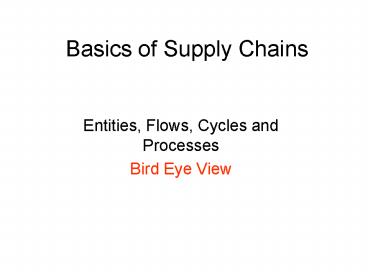Basics of Supply Chains - PowerPoint PPT Presentation
1 / 32
Title:
Basics of Supply Chains
Description:
Financial Analyst: finding ways to reduce cost. Examples of Supply Chains ... Toyota: efficient production. ... plan with the financial plan. Source. Schedule ... – PowerPoint PPT presentation
Number of Views:40
Avg rating:3.0/5.0
Title: Basics of Supply Chains
1
Basics of Supply Chains
- Entities, Flows, Cycles and Processes
- Bird Eye View
2
Outline
- Definitions
- Entity and flow
- Cycles
- Processes 1 Global Supply Chain Forum
- Processes 2 Supply Chain Operations Reference
Model
3
APICS definition of SC
- Global network used to deliver products and
services from raw material to end customers
through an engineered flow of information,
physical distribution and cash.
4
Wrong Definitions/ Perspectives
- 3PL company it is warehouse and transportation
management - ERP vendor it is advanced modules to be added to
the companys original ERP system - Consulting Firm it is strategy building and
market analysis - Financial Analyst finding ways to reduce cost
5
Examples of Supply Chains
- DELL e-commerce and customization.
- Zara innovative versus functional products.
- Toyota efficient production.
- Amazon / Borders / Barnes and Noble bad
synchronization between physical flow and
e-commerce. - Wal-Mart cross-docking, VMI, super Wal-Mart,
data mining etc.
6
- MISSING SLIDES
7
How to View SC
- Entities Flows
- Cycles
- Processes
8
Supply Chain Manufacturing Example
9
- Class Exercise I
10
Thinking processes
- Functional thinking limits cooperation and
impedes creative thinking. - Process management promotes collaboration,
facilitating customer satisfaction at low cost. - Thinking ERP thinking processes
11
- MISSING SLIDES
12
Process Management
- Process Management requires companies to
- Recognize the limiting nature of functional
structures - Instill process thinking throughout the company
- Process integration remains rare
- less than 10 of companies world wide have made a
serious and successful effort - Requires major changes to measurement, job
design, management roles, and organizational
structure
13
Demand Management
- Duties
- Forecasting
- Scheduling plant operations
- Capacity requirements
- Managing inventory
- Fulfilling orders
- Sales tracking
- Why cross-functional, cross-company? , Who?
14
Order fulfillment
- Duties
- Insuring the delivery of the right product at the
right time and location in the right amounts. - Why cross-functional, cross-company? , Who?
15
Manufacturing Flow Management
- Duties
- Managing physical, information and funding flow
- Ensuring the balance between sales and operations
planning - Balancing capacity and demand
- Why cross-functional, cross-company? , Who?
16
Supplier relationship management
- Duties
- Selecting, rating and scoring suppliers
- Building strategic alliances
- Automating the supply process
- Why cross-functional, cross-company? , Who?
17
- Class Exercise II
18
Supply Chain Operations Reference SCOR
- The Supply-Chain Council was established in 1996.
www.supply-chain.org - The Supply-Chain Council now has closer to 1,000
corporate members world-wide and has established
international chapters in North America, Europe,
Greater China, Japan, Australia/New Zealand,
South East Asia, Brazil and Southern Africa.
Development of additional chapters in India and
South America are underway. The Supply-Chain
Council's membership consists primarily
practitioners representing a broad cross section
of industries, including manufacturers, services,
distributors, and retailers.
19
1- Situation mapping
3- Best practices analysis
2- Benchmarking
- Capture
- the as-is state and derive the to-be future
state
- Quantify the best in class practices
- Characterize
- the
- management
- and software
- Practices that
- resulted in
- the best
- practices
20
Supply-Chain Operations Reference (SCOR) Model
- Five core processes for Level 1
- Source
- Make
- Deliver
- Return
- Plan
- Three expanded processes for Level 2
- Planning
- Execution
- Enable
21
Planning
- Balance resources with requirements and
communicate the plan to the whole supply chain - Management of business rules, performances,
compliances and regulatory requirements - Align the unit plan with the financial plan
22
Source
- Schedule deliveries, receive and authorize
supplier payments - Identify and select supply sources when not
predetermined for ETO - Manage business rules, assess suppliers
performance and maintain data
23
- MISSING SLIDES
24
Cascading in SCOR2-Category
25
Cascading in SCOR3-Process elements
26
P3.3 Production plan S1.1, S2.1, S3.3 Scheduled
Receipts M1.2, M1.3, M1.4, M1.5, M1.6
Information Feedback EM5 Equipment and
Facilities Schedules and Plans
Input
P3.2, S1.1, S2.1, S3.3, D1.3, D1.8, D4.2
Production Schedule
Output
27
Cascading in SCOR4-decompose process elements
28
Level 1 KPIs
29
- MISSING SLIDES
30
Limits to SCOR model
- It does not apply to the following processes
- Sales and marketing
- RD
- Product development
- Post delivery customer support
- It also assumes
- training
- Quality
- IT
31
Check list
- Name the basic entities, flows and cycles
involved in SC - Compare between the functional and process views
of SC management - Name the basic processes as defined by the GSCF
model - Name the basic processes as defin
32
Questions ?































